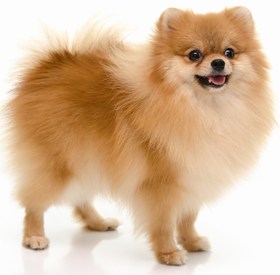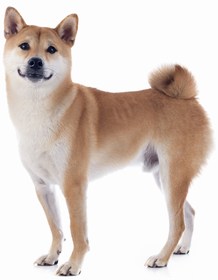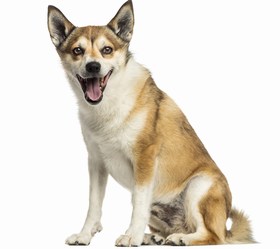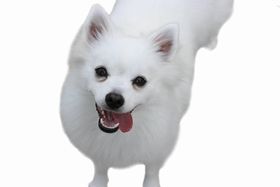
Paws ‘N’ Pups Quickview
Size
| Energy Level
| Trainability
| Paws ‘N’ Pups Rank
|
Characteristics
| Physical Characteristics: Height: 15-20” Weight: 20-30 lbs. Energy Level: Very High | Colors: The American Kennel Club recognizes the Finnish Spitz in only one color:
|
Health & Longevity
Average Life Span: 12-15 years
The Finnish Spitz is typically a very healthy breed; however, like all dog breeds, there are some health problems they can potentially experience.
There are some joint issues that may occur in the Finnish Spitz, particularly patellar luxation and hip dysplasia. Patellar luxation is when the knee joint easily becomes dislocated, sliding in and out of place and causing pain, limping, and potential lameness. Hip dysplasia is a hereditary condition in which the thighbone does not fit properly into the malformed hip joint. In severe cases, hip dysplasia can result in arthritis or lameness. Dogs with hip dysplasia should not breed, so ensure that your puppy’s parents have no history of the condition. Although it is hereditary, hip dysplasia can also be triggered by rapid weight gain or injury.
Hypothyroidism, a condition in which the thyroid gland does not produce adequate amounts of hormone, can also be an issue. Hypothyroidism leads to problems like infertility, obesity, hair loss, and lethargy. It can be treated with daily medication.
Other health issues plaguing some Finnish Spitzes include diabetes, cataracts, and epilepsy. Although epilepsy is not curable, it can be managed with medication.
In general, the Finnish Spitz is a healthy and hardy breed with an average lifespan of 12-15 years.
Temperament & Train-ability
The fox-like Finnish Spitz is extremely loyal, loving, and good natured. He is lively, energetic, and friendly. He is extremely intelligent but also slow to mature, and he can retain silly puppy behaviors for up to four years of age. The Finnish Spitz is emotionally sensitive, and he craves companionship and does not like to be left alone.
Extremely active dogs, Finnish Spitzes require a great deal of exercise and are not recommended for apartment living. At minimum, a couple of thirty minute walks daily are needed. A large yard for the Finnish Spitz to run around in is a definite plus, but be sure your yard is securely fenced; this breed is known for its escape artist capabilities. When outdoors in open spaces, be sure your Finnish Spitz is on a leash, as they are likely to pursue squirrels and other small animals.
This breed is extremely friendly and can get along with most people, including children. In fact, Finnish Spitz adore children and are extremely affectionate and playful with them. They may be aloof and somewhat cautious with strangers. Early socialization will prevent them from becoming shy or fearful. The Finnish Spitz is good with pets that live in the same home, but he can be aggressive with unknown dogs, particularly of the same sex. They make good watchdogs who are sure to alert their owners of dangers, but they are unlikely to show aggression unless absolutely necessary.
Keep in mind that, due to his sensitivity, the Finnish Spitz does not do well in loud or tense environments. If in a home with a lot of noise and arguing, the Finnish Spitz will literally become sick and suffer from stomach problems, so be sure you are able to provide a quiet and peaceful environment. Although the Finnish Spitz does not like loud noise, he does like to bark. The national dog of Finland, the Spitz was bred to hunt a wide variety of game, including bears. They were “bark pointers” who indicate the location of game by barking, and their bark is extremely rapid and high pitched. For this reason, the Finnish Spitz either needs to be trained not to bark when instructed or should live somewhere a bit removed from the nearest neighbors.
Training a Finnish Spitz can be a challenge. Although intelligence is an asset in training, the extreme intelligence of the Finnish Spitz means that they sometimes try to manipulate and outsmart people. They may also grow bored with repetitive training sessions, so try to keep sessions short and varied, and continue challenging your Finnish Spitz. Be firm yet fair, consistent, and patient. Because the Finnish Spitz is slow to mature, they take time to decide whether or not you are in charge, so you must be absolutely consistent in enforcing rules and expectations without being harsh. Ultimately, patient and persistent training will pay off due to this breed’s intelligence and athleticism.
Grooming
Finnish Spitzes are moderate to heavy shedders. Weekly brushing with a slicker brush is recommended, although more frequent brushing will be needed during the spring and fall when they have a heavier shed.
Bathe your dog as needed, at least once every three to four months. This is a clean breed who can typically maintain a nice, shiny appearance with regular brushing, and they do not easily develop an odor.
Trim nails once or twice a month or as needed, and brush teeth at least two or three times weekly to maintain healthy gums and prevent bad breath. Check ears regularly for signs of infection like tenderness, redness, and odor. Also ensure that excessive wax, dirt, or debris does not build up in the ear.
Diet
On average, the Finnish Spitz should eat 1.75-2 cups of high quality dry dog food each day. The proper amount and type of food will vary according to factors such as age, gender, metabolism, activity level, and build.
This breed loves to eat and is especially fond of treats. Do not overfeed, and try to find healthy treats to offer your Finnish Spitz. Otherwise, they can easily become overweight and experience health problems.
Looking for a Finnish Spitz?
 Find A Finnish Spitz Breeder |  Finnish Spitz Puppies For Sale |  Adopt A Finnish Spitz |
Cost
The average cost of a Finnish Spitz is $900-$2000. Pricing varies according to breeder location, gender, pedigree, and if the puppy is considered pet quality or show quality.
Paws ‘N’ Pups Ranking
Paws ‘N’ Pups ranks every breed out of 4 with 1 being easiest to integrate into your life and 4 being the toughest – The lower the ranking the better.
Ranking takes into account a few basic factors including cost, skill level needed, high vs low maintenance and how critical regular training is to success. The Finnish Spitz ranks a 4. They require quite a bit of exercise, can be challenging to train, and are slow to grow out of puppy behaviors. They are also emotionally sensitive and tend to experience separation anxiety. They bark often in a high-pitched, rapid voice, and they can be very heavy shedders. However, this healthy, friendly, beautiful breed can do well with an active and experienced dog owner.
Breeds Similar To Finnish Spitz
 Pomeranian |  Shiba Inu |  Norwegian Lundehund |  American Eskimo Dog |




